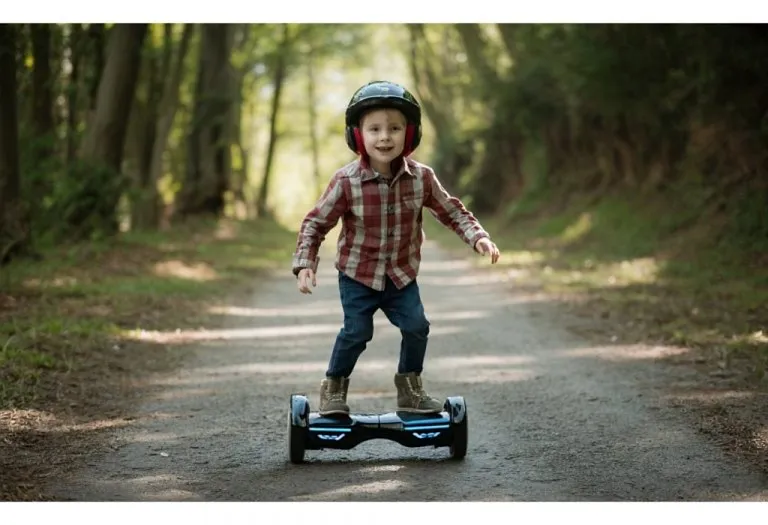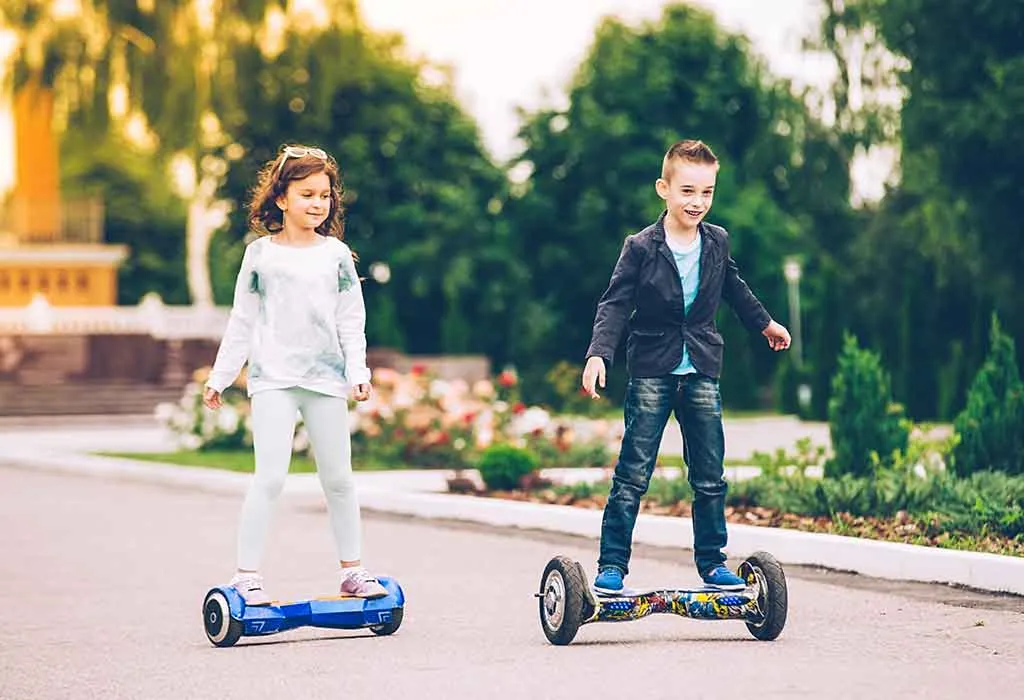Hoverboards for Kids – How Safe Are They?
Hoverboards for kids may be the next big thing in the world of technology. However, while many previous innovations, such as the snowboard and the skateboard, have been a commercial success, the hoverboard has taken off like a shot out of the blue. Hoverboards are becoming increasingly popular among young people and will be found in more places every year. However, as these self-balancing scooters have become ubiquitous on sidewalks and in parks, concerns about their safety have also risen. While hoverboards promise excitement and convenience, parents increasingly question whether these gadgets are safe for their children. Is it any better than the traditional skateboard in terms of performance? Let’s take a closer look at what’s going on.
What Is a Hoverboard?
The term “hoverboard” refers to a self-balancing skateboard that will be available in the future. It is typically constructed of two independent wheels connected to moveable footpads with high flexibility. The rider can control the bike’s motion and direction by turning the front or rear wheels or tilting the pads forward or backwards. Constant developments in hoverboard prototypes imply increased mobility, efficiency, and ease of use, making it safer for kids in the future.
How Does a Hoverboard Work?
According to the latest reports, hoverboards are the next big thing in extreme sports. The mechanism by which a hoverboard operates is fascinating, and we’ll explain it in more detail below.
Hoverboard riders must propel the equipment forward by pushing with their bodies. According to the manufacturer, additional sensors integrated into the hoverboard’s chassis will detect whether or not someone is riding it backwards or in a specific direction. A computer is mounted on the back of a hoverboard and is used to determine the direction of travel.
Many well-known companies have developed new hoverboards with artificial wheels instead of traditional wheels. With the new self-balancing technology of the new hoverboards, they can keep up with fast-moving vehicles without losing their balance. In addition to the additional weight of the artificial wheels, greater friction between the wheels and the frames allows hoverboards to travel faster. Due to insufficient wheels on the self-balancing hoverboards, they may function differently than conventional hoverboards.
Is It Legal to Use a Hoverboard?
The use of Hoverboards on public pavement and other non-road surfaces has proven controversial, with several governments banning their use. Hoverboards cannot be classified as unlawful in any way. Nevertheless, specific regulations must be observed in various areas of the globe.
So, yes and no! People may ride these boards on sidewalks and in most public areas, but you cannot drive them. Several businesses are still developing this highly touted product, but you should only purchase one designed for walking rather than driving. Currently, the only way to operate a hoverboard legally is to receive a ticket from a cop. Numerous police officers consider them dangerous since they are often designed to appear like scooters rather than skateboards.
Are Hoverboards Safe for Your Child?
Is it safe for youngsters to ride hoverboards? Or which hoverboards are safe? Hoverboards were initially designed for youngsters and early teenagers to enjoy. When riding, ensure the kid is wearing all the required safety equipment.
In most instances, children under 13 are not allowed to ride hoverboards. Kids of that age group are immature and reckless, and their judgment and decision-making skills have not fully developed by then. It is better not to put your confidence in them to drive a board that can reach up to 15 miles per hour. While engaging in sports, children should wear all protective gear, such as a helmet and wrist guards. Hoverboards, skateboards, scooters, and bicycles are examples of wheeled devices that parents should enforce a “no helmet, no riding” policy for children who use them.
Is There Any Age Recommendation for Children to Use Hoverboards?
Hoverboard age recommendations vary, but generally, manufacturers suggest a minimum age of 8 to 13 years old for safe operation, depending on the model’s size, weight capacity, and speed capabilities. Schools only allow specifically built kid-sized hoverboards. Get a hoverboard that fits your child’s height and weight so they can have fun while being safe.
Younger children should not use a hoverboard. Children who weigh at least 40 pounds may use the kid hoverboards. This weight barrier is typically reached by age five, but some four-year-olds may reach that weight. Parents should consider several factors before buying a hoverboard for their children.
Benefits of Hoverboards for Kids
The benefits of hoverboards for kids extend beyond mere entertainment. They offer opportunities for physical activity and skill development while adding an element of fun to their daily routines.
1. Improved Balance and Coordination
Hoverboarding requires riders to maintain balance and coordination, which can help improve these skills over time. Kids develop a better sense of body awareness and control as they learn to navigate and manoeuvre the hoverboard.
2. Boosts Confidence and Independence
Mastering the art of hoverboarding instils a sense of accomplishment in kids, boosting their confidence levels. As they gain proficiency in riding, they become more independent, relying on their skills to navigate their environment.
3. Fun Way to Stay Active
Hoverboarding is a fun and engaging form of exercise for kids, keeping them physically active without feeling like a chore. It’s a great alternative to traditional modes of transportation, offering a thrilling ride while burning calories and staying fit.
Risks of Hoverboard for Children
Several people died utilising hoverboards, either from an accident or a fire that started when the board was charging. Wrists, forearms, and heads were among the children’s most commonly injured body parts. Fractures (40%) and bruising (25%) were the most common types of accidents (17 per cent). Other serious injuries, including broken bones and brain damage, have been reported. However, safety concerns arose early on, and hundreds of recalls were issued as a result.
Using a hoverboard for children has the potential to cause skin harm. While this isn’t a life-threatening condition, it’s inevitable. To avoid harming your child in any way, you should constantly take precautions. Using these boards may lead to bruises or open wounds, even if they don’t seem to be serious harm. Keep your hands off of them if you don’t want to hurt your little ones.
Can a Hoverboard Catch Fire?
Yes, hoverboards do catch fire! Overheating of lithium-ion battery packs may cause these self-balancing scooters to explode. It is best not to leave the hoverboard on charge throughout the night. Always keep your hoverboard away from anything that may easily catch fire. All hoverboards need to satisfy the UL 2272 safety standard. This certification does not guarantee the hoverboard’s safety against overheating or burning. The Consumer Product Safety Commission (CPSC) has received several reports of hoverboard battery packs exploding or catching fire. Hoverboards have already been banned by airlines, railroads, and colleges due to safety concerns.
How to Choose a Safe Hoverboard for Kids?
Hoverboards have only recently become popular among young people, even though they were not initially designed for children. When appropriately used, children’s hoverboards may be a lot of fun. Ensuring your children know that their hoverboards are not just toys but actual motorised vehicles is also crucial to helping them become more aware and alert while using them. Make a mental note of the essential features of a hoverboard that must be examined before purchasing.
1. Safety Features
Look for hoverboards that are UL 2272 certified. This certification indicates that they have undergone rigorous testing for electrical and fire safety. It ensures that the hoverboard meets the necessary safety standards and reduces the risk of battery-related accidents.
2. Speed and Weight Limit
Consider the hoverboard’s speed and weight limit to ensure it is appropriate for your child’s age and size. Opt for models with lower maximum speeds and weight capacities, especially for younger children, to minimise the risk of accidents and injuries.
3. Self-Balancing Technology
Choose a hoverboard equipped with self-balancing technology, which helps stabilise the board and prevents it from tipping over. This feature is essential for novice riders and can help reduce the likelihood of falls and collisions.
4. Quality of Materials
Inspect the build quality and materials used to construct the hoverboard. Look for sturdy and durable components that withstand regular use and rough handling. Avoid hoverboards made with cheap or flimsy materials that may pose a safety hazard.
5. Training Modes
Some hoverboards come with beginner or training modes that limit speed and responsiveness, making it easier for kids to learn how to ride safely. Look for models with adjustable riding modes that can customise the speed and sensitivity settings based on your child’s skill level.
Other Safety Concerns for Hoverboard
Even if you don’t have to worry about explosives, there are still some hazards to be aware of in the workplace.
- Falling and Injuring Oneself: Riding a hoverboard, like any other fast-moving vehicle, can be dangerous. With a top speed of about 10 mph, hoverboards pose a greater risk of serious injury than falling off a skateboard, which is slower in motion and thus less dangerous. Although proper safety equipment is required, many riders do not use it. A helmet, knee pads, elbow pads, and wrist protectors are recommended while riding a hoverboard. Falling makes you less likely to sustain fractures, sprains, and other injuries.
- Accidents: Accidents can be common while riding skateboards or bikes, especially if you regularly ride in or near the street. A youngster was killed by a bus while riding a hoverboard in London. Please do not ride a hoverboard on the road or close to traffic unless you live in California, where hoverboards are considered bicycles under state law.
- Bodyweight Restrictions: Hoverboards have weight restrictions, with the lowest being 45 pounds and the highest being 200 pounds (some boards can support up to 300 pounds). You should visit the manufacturer’s website to learn more about these restrictions intended to protect the user and the vehicle. Riders weighing less than the weight limit will have difficulty getting around because the scooters will not sense their weight and will not balance properly. Whether it is safe for your child to ride on a hoverboard is what you’ll have to make the best decision for yourself.
- Hilly Terrain: Most boards do not function while travelling up steep slopes greater than 30 degrees. The panels do not have height restrictions but remember that most raise you about four inches above the ground. Being extraordinarily tall is associated with a higher risk of hitting your head while riding.
Hoverboard Safety Tips for Children
Here are some safety tips to ensure that your children are safe when they are playing with a wheeled toy:
- Children should wear protective equipment such as helmets and wrist guards while riding hoverboards to ensure safety.
- Parents should enforce a straightforward ‘no helmet, no riding’ policy for children who ride on wheeled toys such as hoverboards, skateboards, scooters, and bicycles.
- Allowing them to ride in or near traffic must be strictly prohibited.
- Enrol your child in lessons if they are appropriate for the activity they are participating in. For example, if a child is skateboarding, knowing how to fall correctly can help them avoid serious injuries.
- Examine the entire set of instructions provided by the manufacturer, paying particular attention to any age or weight restrictions that may apply.
- It is strictly forbidden to use any motorised toy that causes overheating.
- To recharge the product, use only the charging cord provided with the equipment.
- Maintain the cleanliness and structural integrity of the wheeled device that your child uses regularly.
FAQs
1. Can hoverboards be used indoors?
While hoverboards are primarily designed for outdoor use, they can also be used indoors with caution. However, indoor use may increase the risk of collisions with furniture or walls, so creating a clear and safe riding area is essential. Additionally, some hoverboards may have restrictions or limitations on indoor use due to their size or design.
2. Are there any regulations or laws regarding using hoverboards in public spaces?
The regulations regarding hoverboard use in public spaces vary depending on location. Riders and parents must familiarise themselves with local laws, including age restrictions, helmet mandates, and designated riding zones. Practising common courtesy, such as yielding to pedestrians and obeying traffic rules, is essential for a safe and harmonious riding experience.
Hoverboards and safety go hand in hand, as ensuring proper usage, maintenance, and adherence to safety guidelines are crucial for minimising the risk of accidents and injuries during operation. These days, kids are very interested in trying new things, and using a hoverboard to transport them to wherever they want to go can be a lot of fun for everyone involved. However, you must establish rules to ensure that your children do not injure themselves or are not injured by others. While attending a hoverboard party, parents should talk about the topics listed above.
Also Read:
Skiing for Kids
Trampolining for Children
Electrical Safety for Kids
Headphones Safety for Children
How to Ensure Children are Safe on Swing?
Was This Article Helpful?
Parenting is a huge responsibility, for you as a caregiver, but also for us as a parenting content platform. We understand that and take our responsibility of creating credible content seriously. FirstCry Parenting articles are written and published only after extensive research using factually sound references to deliver quality content that is accurate, validated by experts, and completely reliable. To understand how we go about creating content that is credible, read our editorial policy here.























